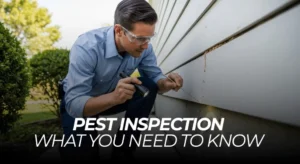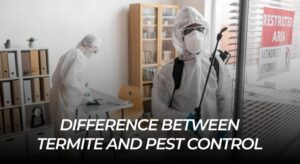Numerous responsibilities come with owning a home. Pest control is one of the least taken care of. Homeowners wait until they can notice damage before they can act. This response method may cost thousands of dollars in repairs and may be devastating to your family in terms of health.
The initial form of protection against undesired visitors is pest inspections. They contribute to the detection of issues before they turn into disasters. A frequent check-up will save you money, secure your place, and ensure the safety of your family. Learning what pest inspection is and why it is important can enable you to make the right judgments regarding the security of your house.
What Are Pest Inspections?
Pest inspection is an all-inclusive assessment of your property. An experienced technician inspects your house and looks at indicators of a pest infestation. They search existing infestations and environments that may be favourable to pests in the future.
These are internal and exterior inspections. Experts verify the basements, attics, crawl spaces, and other spaces. They check aspects like structures, moisture, and access points that pests usually utilize.
Types of Pest Inspections
General Pest Inspections
A general pest inspection includes general household pests. These consist of ants, cockroaches, spiders, and rodents. The inspector investigates your whole property for the appearance of these unwanted guests.
This kind of inspection is best applicable in routine maintenance. It assists in identifying the issues at a young age and eliminates the significant cases of infestation.
Termite Inspections
Termite inspections are specifically aimed at destroying insects that destroy wood. Billions of dollars of property damage are caused by termites every year. They operate quietly and in many cases they are not realized for years.
Special tools and methods are applied by the professional termite inspectors. They look at mud tubes, rotting wood, and swarmers. Thousands of dollars in building repairs can be saved by early detection.
Read Related Article: Difference Between Termite and Pest Control
Specialized Inspections
Certain circumstances involve special inspection. These could be specialized, such as bed bugs or carpenter ants. Specialized inspections involve specific techniques that detect specific threats.
These checks are usually suggested in the event that you believe that a certain pest issue exists. They present in-depth details on how to be treated and prevented.
What Inspectors Look For
Visible Signs of Pests
Pest activity is examined by inspectors looking at visible signs of pest activity. These are droppings, shed skins, and dead insects. They also seek the pests’ nests, webs, and other signs of pest presence.
Another evident indicator is live pests. The inspectors record the kind and quantity of pests that they see during inspection.
Structural Damage
Numerous pests lead to structural damage to homes. The carpenter ants make galleries, and the termites eat wood. Mice are capable of chewing through wires and insulation.
The inspectors check the support beams, the floor joists, and other structural factors. They check on areas of weakness or destruction that may undermine the integrity of your home.
Entry Points
Pests must have a way of getting into your house. Inspectors determine possible areas of entry into your premises. They may involve the cracks on foundations, window gaps, or the utility entry holes.
It is important to seal such entry points in order to eliminate future infestation. These vulnerabilities are usually given suggestions by the inspectors to work on them.
Moisture Issues
- Numerous pests are drawn to moisture.
- Poor ventilation,
- leaky pipes,
- and standing water
are the perfect conditions. The inspectors ensure that there are no moisture issues that could attract pests.
The moisture problem must be addressed to ensure long-term pest management. It eliminates situations that attract unwanted guests to your home. Here are other pest control checklist that must be followed by home owners.
Why Regular Inspections Matter
Early Detection Saves Money
Pest problems have an exponential increase over time. Even a tiny colony of ants can develop into a huge one. There is the possibility of less costly treatment in case of early detection.
When issues are detected at the time of regular inspections, they are easily manageable. This will help to avoid expensive damages and massive treatment needs in the future.
Protecting Your Investment
Probably your biggest investment is your home. This investment may be severely damaged by pests. The United States termites alone cause annual damage of more than five billion dollars.
Frequent checks ensure your property is not devalued. They assist in ensuring the structural integrity of your house and avoiding deterioration of your house by pests.
Health and Safety Benefits
Numerous pests are health hazards to your family. Cockroaches are also capable of causing asthma and allergies. Diseases can be transmitted by rodents in the form of droppings and urine.
Frequent check-ins are used to sustain a good living environment. They do not subject your family to health risks associated with pests.
Peace of Mind
There is inestimable comfort in knowing that your house is pest-free. Periodic inspections remove any doubts regarding the status of your property. You can have an easy mind knowing that some issues that may arise are under control.
This is the peace of mind that new homeowners especially require. It makes them become more familiar with their property and be ahead of the problems that could be encountered.
When to Schedule Inspections.
Routine Inspection Schedule
The majority of specialists suggest that pest checks should be done yearly. This frequency captures a majority of the problems before they are severe. There are also high-risk areas that could use a higher number of inspections.
The seasonal inspections may be especially beneficial. The spring inspections are made ready for the rise of more pests. Fall inspection can be used to find the problems prior to winter when pests are looking to find shelter indoors.
Situational Inspections
Some cases require instant checks. These consist of suspected infestations, odd pests, or structural issues. Waiting until the regular inspection is over is not worthwhile when you see signs of warning.
Inspections may also be caused by the recent weather events. Disasters, like floods, storms, etc., may provide a conducive environment to pests.
Making the Most of Your Investment
Regular pest inspection is an investment in your future property. They take care of your house, your health, and your money. The possible damage costs are much higher than the cost of inspections.
Always act before you get to see the problems. Book your pest inspection and make the first step to safeguarding the most important asset. The future you will thank you for will be because of this active attitude towards housekeeping.
Related Reading: What is Pest Treatment? When to Consider it?







